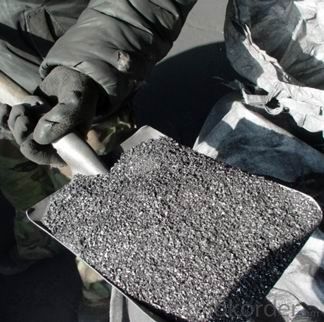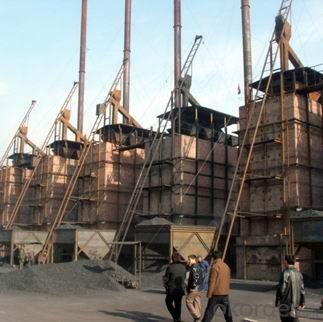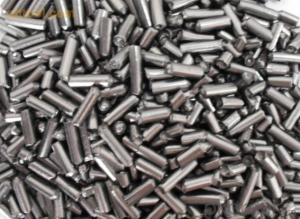Calcined Anthracite Coal Carbon Additive FC 90-95%
- Loading Port:
- Tianjin
- Payment Terms:
- TT or LC
- Min Order Qty:
- 20 m.t.
- Supply Capability:
- 10000 m.t./month
OKorder Service Pledge
OKorder Financial Service
You Might Also Like
Quick Details
Place of Origin: Ningxia, China (Mainland)
Application: steel making
Shape: granule
Dimensions: FC90-95%
Product Type: Carbon Additive
C Content (%): 90-95% MIN
Working Temperature: -
S Content (%): 0.5%MAX
N Content (%): -
H Content (%): 0.6%MAX
Ash Content (%): 8.5%MAX
Volatile: 2%MAX
ADVANTAGE: low ash & sulfur
COLOR: Black
RAW MATERIAL: TaiXi anthracite
Packaging & Delivery
| Packaging Details: | In 1MT plastic woven bag. |
|---|---|
| Delivery Detail: | 30-40DAYS |
Specifications
Calcined Anthracite Coal Carbon Additive FC 90-95%
Carbon Additve low Ash,S,P
FC>95% ASH<4% S<0.3%
It is made from TaiXi anthracite.
instead of pertrol coke reduce the cost
Structure
Calcined Anthracite Coal Carbon Additive FC 90-95%
Shape: granule
Dimensions: FC90-95%
Product Type: Carbon Additive
C Content (%): 90-95% MIN
Working Temperature: -
S Content (%): 0.5%MAX
N Content (%): -
H Content (%): 0.6%MAX
Ash Content (%): 8.5%MAX
Volatile: 2%MAX
ADVANTAGE: low ash & sulfur
COLOR: Black
RAW MATERIAL: TaiXi anthracite
Feature
Calcined Anthracite Coal Carbon Additive FC 90-95%
Specifications (%): | ||||||
Grade | F.C | Ash | V.M | Moisture | S | Size |
CR-95 | ≥95 | <4 | <1 | <1 | <0.3 | 0-30mm |
CR-94 | ≥94 | <4 | <1 | <1 | <0.3 | |
CR-93 | ≥93 | <6 | <1 | <1 | <0.4 | |
CR-92 | ≥92 | <7 | <1 | <1 | <0.4 | |
CR-91 | ≥91 | <8 | <1 | <1 | <0.4 | |
CR-90 | ≥90 | <8.5 | <1.5 | <2 | <0.4 | |
Image
Calcined Anthracite Coal Carbon Additive FC 90-95%


FAQ:
Calcined Anthracite Coal Carbon Additive FC 90-95%
Why we adopt carbon additive?
Carbon Additives used as additive in steel making process. It made from well-selected Tai Xi anthracite which is low in content of ash, sulphur, phosphorus, high heat productivity, high chemically activation.
Mainly industry property of it is: instead of traditional pertroleum coal of Carbon Additives, reduce the cost of steelmaking.
Advantage:
Calcined Anthracite Coal Carbon Additive FC 90-95%
1.High quality and competitive price.
2.Timely delivery.
3.If any item you like. Please contact us.
Your sincere inquiries are typically answered within 24 hours.
- Q:What is carbon offsetting in the hospitality industry?
- The hospitality industry engages in carbon offsetting as a means of counteracting the greenhouse gas emissions generated by hotels, resorts, and other businesses in the sector. This practice serves to offset the carbon footprint resulting from various activities within the industry, including energy consumption, transportation, waste management, and water usage. To engage in carbon offsetting, hospitality establishments first calculate the quantity of carbon dioxide or other greenhouse gases they emit. They then invest in projects aimed at reducing emissions in other locations. Examples of such projects include initiatives focused on renewable energy, reforestation, or energy efficiency. Through supporting these projects, the hospitality industry strives to offset or neutralize its own carbon emissions and thereby minimize its impact on climate change. Hotels and resorts have the option to purchase carbon offsets from specialized organizations that facilitate carbon offset projects. These organizations ensure that the offsets are verified and adhere to recognized standards, such as the Verified Carbon Standard or the Gold Standard. By investing in verified offsets, the hospitality industry can have confidence that their contributions effectively contribute to reducing global greenhouse gas emissions. Carbon offsetting in the hospitality industry not only showcases environmental responsibility but also offers economic advantages. A growing number of travelers are increasingly conscious of the environmental consequences associated with their accommodation choices. As a result, they actively seek out hotels and resorts that prioritize sustainability. By implementing carbon offsetting programs, hospitality businesses can attract environmentally conscious guests and stand out in a competitive market. Moreover, carbon offsetting is just one component of a wider sustainability strategy within the hospitality industry. Many hotels and resorts are also adopting energy-efficient practices, implementing waste reduction measures, and promoting water conservation. By combining these efforts with carbon offsetting initiatives, the hospitality industry can contribute to a more sustainable future while simultaneously improving their financial performance. In conclusion, carbon offsetting in the hospitality industry involves investing in projects that reduce greenhouse gas emissions in order to compensate for the carbon footprint generated by hotels and resorts. This practice enables the industry to nullify its environmental impact and demonstrate a commitment to sustainability. Through the implementation of carbon offsetting programs, the hospitality industry can attract environmentally conscious guests, differentiate itself in the market, and contribute to a more sustainable future.
- Q:What is carbon nanoelectrode?
- A carbon nanoelectrode is a type of electrode that is made from carbon-based materials, typically in the form of a nanotube or nanowire. These electrodes are extremely small, with diameters on the nanoscale, typically ranging from a few to a few hundred nanometers. Carbon nanoelectrodes have unique properties that make them highly desirable for use in various applications, particularly in the field of electrochemistry. Due to their small size, they offer a large surface area to volume ratio, which allows for enhanced sensitivity and improved electrochemical performance. The carbon nanoelectrodes also possess excellent electrical conductivity and mechanical strength, making them ideal for use in miniaturized electronic devices and sensors. They can be easily integrated into various platforms, such as microfluidic systems or biosensors, enabling efficient and accurate detection of chemical or biological species. Moreover, carbon nanoelectrodes have shown great potential in energy storage devices, such as supercapacitors and batteries, due to their high electrical conductivity and large surface area, which facilitate rapid charge and discharge rates. Overall, carbon nanoelectrodes represent a promising advancement in the field of nanotechnology, offering unique properties and unparalleled performance for various applications in electronics, sensing, and energy storage.
- Q:How does carbon impact the availability of sustainable development policies?
- Carbon impacts the availability of sustainable development policies by directly contributing to climate change. The excessive emission of carbon dioxide and other greenhouse gases from human activities leads to global warming, which in turn affects natural resources, ecosystems, and communities. To mitigate the negative impacts of carbon, sustainable development policies aim to reduce carbon emissions, promote renewable energy sources, and encourage sustainable practices. By addressing carbon emissions, these policies help create a more sustainable future by preserving resources, minimizing environmental degradation, and fostering social and economic well-being.
- Q:What are the effects of carbon emissions on the stability of peatlands?
- Peatlands, composed of dead plants and mosses, are wetland ecosystems that act as important carbon sinks. However, the stability of these ecosystems is significantly impacted by carbon emissions, resulting in various environmental and ecological consequences. When carbon emissions, particularly from burning fossil fuels, are released into the atmosphere, they contribute to the overall increase in greenhouse gases like carbon dioxide (CO2) and methane (CH4). This increase in greenhouse gases leads to global warming and climate change, directly affecting peatlands. One primary consequence of carbon emissions on peatlands is the acceleration of peat decomposition. Global warming raises temperatures, increasing microbial activity in peatlands and speeding up the decomposition of organic matter. This process releases carbon dioxide and methane, further contributing to greenhouse gas emissions. It also causes peatlands to sink or subside, impacting their stability and contributing to land degradation. Furthermore, carbon emissions can change the hydrology of peatlands. Rising temperatures cause increased evaporation and reduced precipitation, resulting in drier conditions. This can cause the water tables to drop, inhibiting moss growth and the accumulation of new peat. As a result, peatlands become less effective at sequestering carbon and can even become sources of carbon emissions. The destabilization of peatlands due to carbon emissions has cascading effects on the entire ecosystem. Peatlands provide habitats for numerous unique and highly adapted plant and animal species. However, the drying and sinking of peatlands disrupt these ecosystems, leading to changes in species composition and distribution, as well as increased vulnerability to invasive species. Additionally, the release of carbon dioxide and methane from peatlands amplifies climate change. These greenhouse gases trap heat in the atmosphere, further warming the planet and exacerbating the cycle of peat decomposition and carbon emissions. In conclusion, carbon emissions have damaging effects on peatland stability, including accelerated peat decomposition, altered hydrology, and ecosystem disruption. These impacts hinder the ability of peatlands to sequester carbon and contribute to climate change, creating a negative feedback loop. It is essential to reduce carbon emissions and prioritize the preservation and restoration of peatlands to mitigate these effects and protect these valuable ecosystems.
- Q:What are the impacts of carbon emissions on water scarcity?
- Water scarcity is significantly impacted by carbon emissions. One way in which carbon emissions contribute to water scarcity is through climate change. The presence of increased carbon dioxide in the atmosphere causes heat to become trapped, resulting in global warming and changes in weather patterns. These altered climate patterns can lead to changes in rainfall, including more frequent droughts and decreased rainfall in certain areas. The consequences of droughts can be particularly severe for water availability. When there is a lack of rainfall, rivers, lakes, and reservoirs can dry up, leaving communities without access to fresh water sources. This scarcity of water affects drinking water, agriculture, and industrial use, impacting both human populations and ecosystems. Moreover, carbon emissions also affect water scarcity by impacting the melting of glaciers and snowpack in mountainous regions. These areas serve as natural water reservoirs, releasing water slowly throughout the year and providing a reliable source of freshwater downstream. However, as temperatures rise due to carbon emissions, glaciers and snowpack melt at a faster rate. This leads to increased water runoff, resulting in flooding and a decrease in water availability during dry seasons. Carbon emissions also indirectly contribute to water scarcity through their influence on sea-level rise. The increased temperatures caused by carbon emissions cause polar ice caps to melt, which in turn raises sea levels. Consequently, saltwater infiltrates coastal aquifers, making the groundwater brackish or undrinkable. This intrusion contaminates freshwater sources, reducing their availability and exacerbating water scarcity. Additionally, carbon emissions contribute to ocean acidification, which harms marine ecosystems. This, in turn, affects the availability of seafood resources, which are an essential source of protein for many people worldwide. The decline in seafood availability puts additional pressure on freshwater resources as it may lead to increased reliance on agriculture, which requires substantial amounts of water. To summarize, carbon emissions have significant impacts on water scarcity. Climate change resulting from carbon emissions alters precipitation patterns, leading to droughts and reduced rainfall. Carbon emissions also accelerate the melting of glaciers and snowpack, reducing water availability in mountainous regions. Furthermore, carbon emissions contribute to sea-level rise, resulting in saltwater intrusion into freshwater sources. These impacts emphasize the urgent need to reduce carbon emissions and mitigate the effects of climate change to ensure the availability of freshwater resources for present and future generations.
- Q:What are the different types of carbon-based inks?
- There are various types of carbon-based inks, including carbon black ink, graphite ink, and carbon nanotube ink.
- Q:What is the difference in carbon content of low carbon steel, medium carbon steel and high carbon steel?
- The carbon content of high carbon steel (AISI1055 ~ 1095) is 0.60% to 1.03%, manganese content is 0.30% to 0.90%, phosphorus content is not more than 0.04%, sulfur content is not more than 0.05%.
- Q:How does carbon impact the availability of renewable energy sources?
- Carbon impacts the availability of renewable energy sources in a number of ways. Firstly, carbon emissions from the burning of fossil fuels contribute to climate change, which is a significant threat to the availability and sustainability of renewable energy sources. The increased frequency and intensity of extreme weather events caused by climate change can damage renewable energy infrastructure, such as wind turbines and solar panels. Secondly, carbon-intensive industries, such as coal mining and oil extraction, can limit the growth and development of renewable energy technologies. These industries have historically received substantial subsidies and support from governments, which can hinder the progress of renewable energy by diverting resources and investment away from cleaner alternatives. Furthermore, carbon emissions contribute to air pollution, which can have negative impacts on the efficiency and performance of renewable energy systems. For example, air pollution can reduce the amount of sunlight reaching solar panels or obstruct wind flow to turbines, thereby decreasing their energy output. Additionally, the reliance on carbon-based energy sources creates a significant market competition for renewable energy. Fossil fuels often have lower costs due to their established infrastructure and economies of scale, making it challenging for renewable energy sources to compete on a cost basis. This can limit the availability and accessibility of renewable energy options, particularly in developing countries where fossil fuels are often the cheaper and more readily available option. To address these challenges, it is crucial to reduce carbon emissions through transitioning to renewable energy sources and implementing policies that incentivize their adoption. By reducing carbon emissions, we can mitigate the impacts of climate change on renewable energy infrastructure and create a more conducive environment for the development and deployment of clean energy technologies.
- Q:What are the consequences of increased carbon emissions on forest ecosystems?
- Increased carbon emissions have a range of negative consequences on forest ecosystems. Firstly, higher levels of carbon dioxide in the atmosphere contribute to global warming, leading to higher temperatures and altered precipitation patterns, which can negatively impact the growth and health of forest plants. Additionally, increased carbon dioxide levels can stimulate the growth of invasive plant species, leading to competition and reduced biodiversity. Moreover, carbon emissions contribute to ocean acidification, which can harm marine ecosystems that are interconnected with forests. Lastly, increased carbon emissions can intensify the frequency and severity of wildfires, posing a significant threat to forest ecosystems and their ability to regenerate.
- Q:What are the impacts of carbon emissions on the stability of savannas?
- Carbon emissions have significant impacts on the stability of savannas, which are delicate and diverse ecosystems. One of the main consequences of carbon emissions is the increase in greenhouse gases, such as carbon dioxide, in the atmosphere. This leads to global warming, which has several direct and indirect effects on savannas. Firstly, higher temperatures resulting from global warming can alter the natural fire regimes in savannas. These ecosystems are adapted to periodic fires, which play a crucial role in maintaining their structure and biodiversity. However, increased temperatures can intensify and prolong fire seasons, leading to more frequent and intense wildfires. This can disrupt the natural balance, causing the loss of vegetation, changes in species composition, and reducing the overall stability of the savanna ecosystem. Secondly, elevated carbon dioxide levels can affect the physiology and growth of plants. While some studies suggest that increased CO2 concentrations may enhance plant productivity in savannas, it is important to consider other factors such as nutrient availability and water availability. If these factors do not keep pace with increased carbon dioxide levels, the positive effects on plant growth may be limited, leading to imbalances in the ecosystem. Furthermore, carbon emissions contribute to climate change, which alters rainfall patterns and distribution. Savannas rely on a delicate balance between wet and dry seasons. Changes in precipitation patterns can disrupt this balance, affecting the availability of water for plants and animals. This can lead to shifts in species distribution, reduced habitat suitability, and increased competition for limited resources, further destabilizing the savanna ecosystem. Lastly, carbon emissions also contribute to ocean acidification, which affects marine ecosystems. Coral reefs, which are interconnected with savannas through coastal regions, provide essential habitat and protection for many marine species. Acidic waters can harm coral reefs, leading to their decline and subsequent loss of biodiversity in savanna ecosystems. In conclusion, carbon emissions have significant impacts on the stability of savannas. Global warming, changes in fire regimes, altered precipitation patterns, and ocean acidification all affect the delicate balance and biodiversity of these ecosystems. It is crucial to address carbon emissions and mitigate their effects to ensure the long-term stability and conservation of savannas and the services they provide.
1. Manufacturer Overview |
|
|---|---|
| Location | |
| Year Established | |
| Annual Output Value | |
| Main Markets | |
| Company Certifications | |
2. Manufacturer Certificates |
|
|---|---|
| a) Certification Name | |
| Range | |
| Reference | |
| Validity Period | |
3. Manufacturer Capability |
|
|---|---|
| a)Trade Capacity | |
| Nearest Port | |
| Export Percentage | |
| No.of Employees in Trade Department | |
| Language Spoken: | |
| b)Factory Information | |
| Factory Size: | |
| No. of Production Lines | |
| Contract Manufacturing | |
| Product Price Range | |
Send your message to us
Calcined Anthracite Coal Carbon Additive FC 90-95%
- Loading Port:
- Tianjin
- Payment Terms:
- TT or LC
- Min Order Qty:
- 20 m.t.
- Supply Capability:
- 10000 m.t./month
OKorder Service Pledge
OKorder Financial Service
Similar products
New products
Hot products
Hot Searches






























